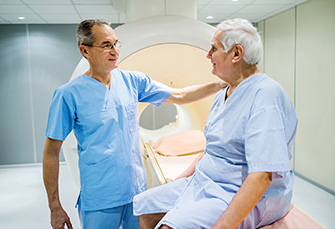Radiation oncology
You can get the latest advances in cancer radiation treatment with leading radiation oncology providers at HonorHealth Cancer Care.
Radiation therapy kills cancer cells or slows down their growth. Radiation therapy also can ease cancer symptoms caused by a tumor by relieving pressure from a tumor.
Radiation therapy is useful because cancer cells are more vulnerable to radiation than healthy tissue. Precise targeting of radiation beams can prevent radiation from affecting surrounding tissue. Focused radiation shrinks tumors and kills cancer cells by destroying their genetic material, preventing them from growing and dividing. Radiation effectively eliminates small amounts of cancer that might remain after surgery or chemotherapy.
Cancer cells treated with radiation don’t die right away – they just can’t keep growing. Over time, the cells will die off and be cleared away by the immune system.
Radiation therapy may be used to treat almost every type of solid tumor, including cancers of the brain, breast, cervix, larynx, lung, pancreas, prostate, skin, spine, or soft-tissue sarcomas.
Today's high-precision techniques allow the delivery of higher doses of radiation with a dramatic reduction in side effects.
How is radiation therapy delivered?

It can be delivered in two ways, externally and internally:
- External beam radiation therapy is more common. Using photons or electrons, it can be used for most types of cancer even if it has spread to other areas in the body. Treatments typically are performed on an outpatient basis over a one- to two-month period.
- Internal radiation therapy, also called brachytherapy, uses radiation in the form of a small implant or seed. This radioactive substance can be inserted close to the tumor, or directly inside it using flexible tubes called catheters to guide it. Typically used on small tumors confined to one area of the body, internal radiation may require a hospital stay. Brachytherapy is used to treat cancers of the head and neck, breast, cervix, prostate and eye.
Radiation may be given before, during or after surgery. Doctors may use radiation:
- Before surgery, to shrink the size of the cancer
- During surgery, to go straight to the cancer without passing through the skin. Radiation therapy used this way is called intraoperative radiation
- After surgery, to kill any remaining cancer cells
Radiation may also be given before, during, or after other cancer treatments to shrink the cancer or to kill any cancer cells that might remain.
Side effects of radiation therapy
As it kills or slows the growth of cancer cells, radiation therapy can affect nearby normal cells. You may feel tired — suddenly or all at once. Depending on how much fatigue you feel, you may need to ask for help with meals, transportation or child care.
To protect healthy cells, your radiation expert will:
- Use as low a dose as possible
- Spread treatment over time, allowing normal cells to recover while cancer cells die
- Aim radiation at a certain part of your body, using a computer to pinpoint the beam
Sometimes, your doctor will change the radiation dose or schedule to reach the total dose of radiation more quickly.
How often will you have treatment?
Most people have external beam radiation therapy with the same dose of radiation once a day, five days a week, on an outpatient basis. Treatment lasts up to six weeks, depending on your treatment plan.
Learn more about the various forms of radiation therapy offered with leading radiation oncology providers at HonorHealth Cancer Care: